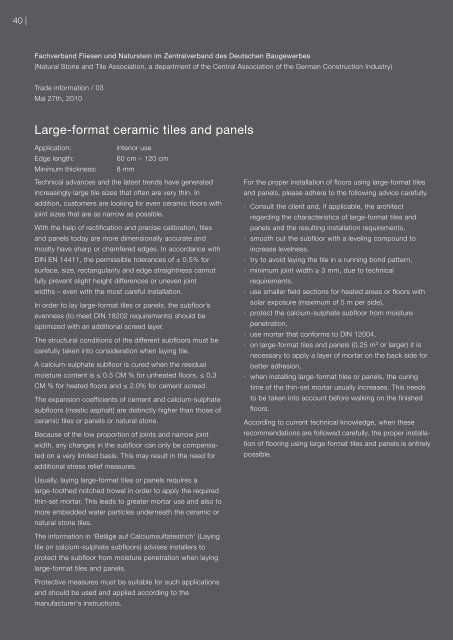Fliesen mit Format tiles with style Carrelage de ... - petraluxe.de
Fliesen mit Format tiles with style Carrelage de ... - petraluxe.de
Fliesen mit Format tiles with style Carrelage de ... - petraluxe.de
You also want an ePaper? Increase the reach of your titles
YUMPU automatically turns print PDFs into web optimized ePapers that Google loves.
40 |<br />
Fachverband <strong>Fliesen</strong> und Naturstein im Zentralverband <strong>de</strong>s Deutschen Baugewerbes<br />
(Natural Stone and Tile Association, a <strong>de</strong>partment of the Central Association of the German Construction Industry)<br />
Tra<strong>de</strong> information / 03<br />
Mai 27th, 2010<br />
Large-format ceramic <strong>tiles</strong> and panels<br />
Application: interior use<br />
Edge length: 60 cm – 120 cm<br />
Minimum thickness: 8 mm<br />
Technical advances and the latest trends have generated<br />
increasingly large tile sizes that often are very thin. In<br />
addition, customers are looking for even ceramic floors <strong>with</strong><br />
joint sizes that are as narrow as possible.<br />
With the help of rectification and precise calibration, <strong>tiles</strong><br />
and panels today are more dimensionally accurate and<br />
mostly have sharp or chamfered edges. In accordance <strong>with</strong><br />
DIN EN 14411, the permissible tolerances of ± 0.5% for<br />
surface, size, rectangularity and edge straightness cannot<br />
fully prevent slight height differences or uneven joint<br />
widths – even <strong>with</strong> the most careful installation.<br />
In or<strong>de</strong>r to lay large-format <strong>tiles</strong> or panels, the subfloor’s<br />
evenness (to meet DIN 18202 requirements) should be<br />
optimized <strong>with</strong> an additional screed layer.<br />
The structural conditions of the different subfloors must be<br />
carefully taken into consi<strong>de</strong>ration when laying tile.<br />
A calcium-sulphate subfloor is cured when the residual<br />
moisture content is ≤ 0.5 CM % for unheated floors, ≤ 0.3<br />
CM % for heated floors and ≤ 2.0% for cement screed.<br />
The expansion coefficients of cement and calcium-sulphate<br />
subfloors (mastic asphalt) are distinctly higher than those of<br />
ceramic <strong>tiles</strong> or panels or natural stone.<br />
Because of the low proportion of joints and narrow joint<br />
width, any changes in the subfloor can only be compensated<br />
on a very li<strong>mit</strong>ed basis. This may result in the need for<br />
additional stress relief measures.<br />
Usually, laying large-format <strong>tiles</strong> or panels requires a<br />
large-toothed notched trowel in or<strong>de</strong>r to apply the required<br />
thin-set mortar. This leads to greater mortar use and also to<br />
more embed<strong>de</strong>d water particles un<strong>de</strong>rneath the ceramic or<br />
natural stone <strong>tiles</strong>.<br />
The information in ‘Beläge auf Calciumsulfatestrich‘ (Laying<br />
tile on calcium-sulphate subfloors) advises installers to<br />
protect the subfloor from moisture penetration when laying<br />
large-format <strong>tiles</strong> and panels.<br />
Protective measures must be suitable for such applications<br />
and should be used and applied according to the<br />
manufacturer‘s instructions.<br />
For the proper installation of floors using large-format <strong>tiles</strong><br />
and panels, please adhere to the following advice carefully.<br />
· Consult the client and, if applicable, the architect<br />
regarding the characteristics of large-format <strong>tiles</strong> and<br />
panels and the resulting installation requirements,<br />
· smooth out the subfloor <strong>with</strong> a leveling compound to<br />
increase levelness,<br />
· try to avoid laying the tile in a running bond pattern,<br />
· minimum joint width ≥ 3 mm, due to technical<br />
requirements,<br />
· use smaller field sections for heated areas or floors <strong>with</strong><br />
solar exposure (maximum of 5 m per si<strong>de</strong>),<br />
· protect the calcium-sulphate subfloor from moisture<br />
penetration,<br />
· use mortar that conforms to DIN 12004,<br />
· on large-format <strong>tiles</strong> and panels (0.25 m2 or larger) it is<br />
necessary to apply a layer of mortar on the back si<strong>de</strong> for<br />
better adhesion,<br />
· when installing large-format <strong>tiles</strong> or panels, the curing<br />
time of the thin-set mortar usually increases. This needs<br />
to be taken into account before walking on the finished<br />
floors.<br />
According to current technical knowledge, when these<br />
recommendations are followed carefully, the proper installation<br />
of flooring using large-format <strong>tiles</strong> and panels is entirely<br />
possible.<br />
You can view or download our many certifications at our website www.<strong>petraluxe</strong>.com<br />
Petraluxe GmbH<br />
Siemensstraße 34 · 06449 Aschersleben · Germany<br />
Phone: +49 (0) 3473 - 91 37 40 · Fax: +49 (0) 3473 - 9 13 74 09<br />
e-mail: info@<strong>petraluxe</strong>.com · Internet: www.<strong>petraluxe</strong>.com<br />
Last updated: 01.2013<br />
| 41<br />
english


